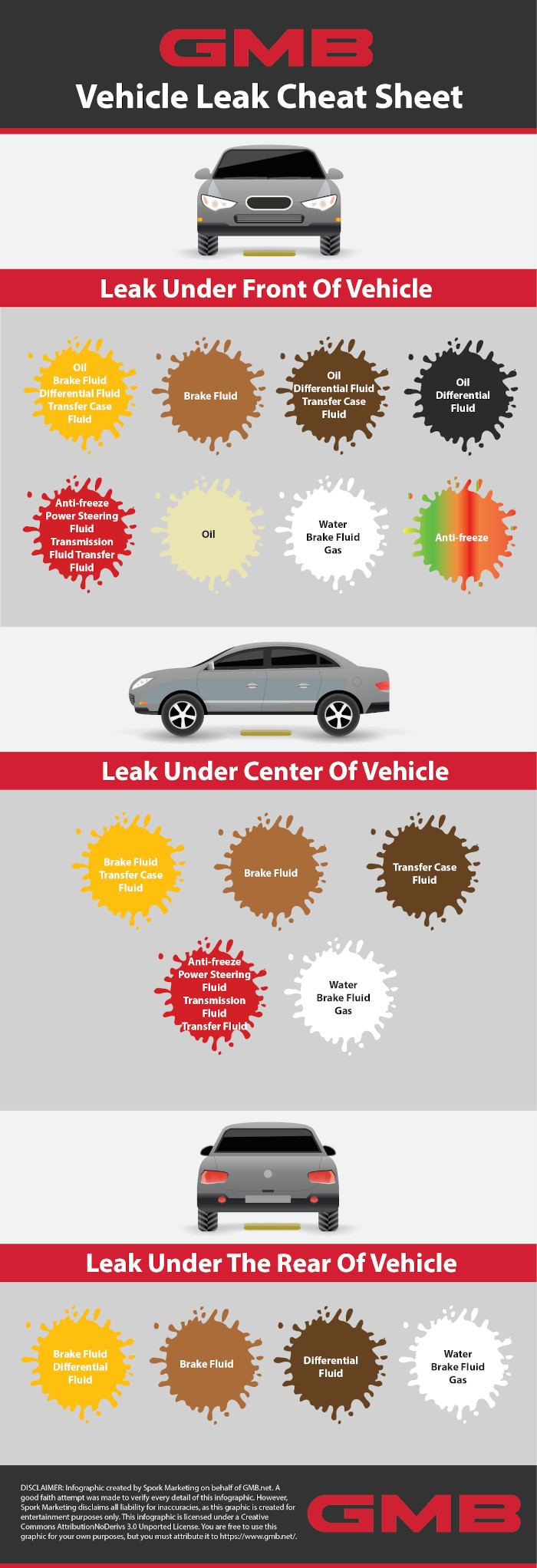What’s That Leak? Use GMB’s Leak Cheat Sheet To Find Out!
Your vehicle is loaded with fluids: motor oil, antifreeze, transmission fluid, and so on. So when your vehicle springs a leak, it can be difficult to identify the leak and fix the issue. If your vehicle is leaking and you’re having trouble figuring out the cause of the leak, this guide may help you.
This cheat sheet will help you identify the leak by:
- The location of the leak
- The color of the fluid
So the first question we want to ask is: where is the leak located? We’ll cover three general areas:
- The front of the vehicle
- The center of the vehicle
- The rear of the vehicle
Check the infographic below to find the location of your leak and all the possible causes.

Front Of The Vehicle
Most of the leaks occur in the front of the vehicle, from the engine compartment. If your leak is in that area, check the color of the fluid. Find the color in the list below. Next, jump ahead to the end of this post to read more about the possible cause(s) of the leak.
Amber
- Oil leak
- Brake fluid leak
- Differential fluid leak (if your vehicle has a front differential)
- Transfer case fluid leak
Dark Gold
- Brake fluid leak
Dark Brown
- Oil leak
- Differential fluid leak (if your vehicle has a front differential)
- Transfer case fluid leak
Black
- Oil leak
- Differential fluid leak (if your vehicle has a front differential)
Cream
- Oil leak
Red
- Anti-freeze leak
- Power steering fluid leak
- Transmission fluid leak
- Transfer case fluid leak
Clear
- Water leak
- Brake fluid leak
- Gas leak
Green, Orange, Yellow, Blue, Pink, or Purple
- Anti-freeze leak
Center Of The Vehicle
If the leak is in the center of the vehicle, check the color of the fluid. Next, find the color in the list below to see the possible cause(s) of the leak. Jump ahead to the end of this post to read more about the possible cause(s) of the leak.
Clear
- Water leak
- Brake fluid leak
- Gas leak
Dark Gold
- Brake fluid leak
Amber
- Brake fluid leak
- Transfer case fluid leak
Red
- Transmission fluid leak
- Transfer case fluid leak
Dark Brown
- Transfer case fluid leak
Rear Of The Vehicle
Is the leak in the rear of the vehicle? Check the color of the fluid. Refer to the list below for the possible cause(s) of the leak. Next, jump ahead to the end of this post to read more about the possible cause(s) of the leak.
Clear
- Water leak
- Brake fluid leak
- Gas leak
Dark Gold
- Brake fluid leak
Amber
- Brake fluid leak
- Differential fluid leak (if your vehicle has a rear differential)
Dark Brown
- Differential fluid leak (if your vehicle has a rear differential)
Black
- Differential fluid leak (if your vehicle has a rear differential)
The Most Common Leaks
Here’s a non-exhaustive list of the most common leaks.
1. Oil Leak
Color(s): Amber, dark brown, black, cream
Location(s): Front of the vehicle
If you just changed the oil in your vehicle, it’s possible that there’s a leak from one of the following parts:
- Drain plug
- Oil filter
Grab a flashlight and then check the drain plug and oil filter for any leaks. Make sure that both parts are screwed on tight enough. Also, clean any excess oil you see. If you don’t find any leaks coming from either part, check the following parts:
- Oil pan gasket
- Timing cover gasket (leaks from this area may indicate that the front main seal is leaking)
- Bell housing (leaks from this area may indicate that the rear main seal is leaking)
- Rocker cover gasket
- Valve cover gaskets
Are these parts not leaking? There may be some structural damage such as cracks or holes in the oil pan or the engine block.
2. Anti-Freeze Leak
Color(s): Green, orange, yellow, blue, pink, red, purple
Location(s): Front of the vehicle
Anti-freeze leaks are quite common, and there are several possible sources of the leak. A leak can indicate that there’s a crack or pinhole somewhere in the radiator. Or it can indicate that the water pump is failing. Anti-freeze leaks can put your engine at risk of overheating. If you suspect that your vehicle may have an anti-freeze leak, take the following steps:
- Check the upper and lower radiator hoses for any cracks or loose fittings.
- Check the radiator for any antifreeze residue, damage, or corrosion.
- Check the water pump weep hole and gasket for leakage. These are the 4 most common causes of water pump failure.
If you’re not sure where the leak is coming from, bring your vehicle to a shop. They’ll perform a coolant pressure test. It should help pinpoint the location of the leak.
Useful tip: When adding more coolant to your vehicle to compensate for the loss of coolant, be sure to add the right type of anti-freeze. This post explains why it’s very important to use the right coolant.
Did you notice a brown milky sludge in your coolant? Or does the coolant color look off? Chances are its contaminated with oil, contaminated with transmission fluid, or something else. If you have contaminated coolant, we urge you to find the problem and fix it. If you continue to drive your vehicle without fixing the issue, it may lead to expensive repairs.
3. Power Steering Fluid Leak
Color(s): Red
Location(s): Front of the vehicle
Want to confirm that there’s a power steering leak in your vehicle? Check the following parts for leaks, cracks, or loose fittings:
- Power steering pressure hose
- Return hose
- Power steering pump
- Power steering reservoir
4. Water Leak
Color(s): Clear
Location(s): Front, center, or rear of the vehicle
The good news here is water leaks are common and normally harmless. The AC compressor has a tube that drains water condensation when needed. This is especially common when you have the AC cranked up at full blast. If you see a little bit of water dripping out of your exhaust pipe(s), you have nothing to worry about. It’s likely condensation from water and carbon dioxide in the pipes. In most cases, a water leak isn’t anything to worry about. If you don’t notice any other issues with your vehicle, and if the water leak is minimal, then you shouldn’t worry.
5. Brake Fluid Leak
Color(s): Dark gold, amber, clear
Location(s): Front, center, or rear of the vehicle
A brake fluid leak is a pretty big deal. If your vehicle’s braking system loses enough fluid, it will no longer be effective in stopping your vehicle. So if you believe that you have a brake fluid leak, check the calipers first. It’s the most common location of a brake fluid leak. If there’s no leak present in any of the calipers, check the:
- Brake master cylinder
- Brake lines
- Brake fluid reservoir
6. Differential Fluid Leak
Color(s): Amber, dark brown, black
Location(s): Front or rear of the vehicle
If your vehicle has a differential or two differentials, it’s possible that you’re dealing with a differential fluid leak. Fluid may be leaking out of the fill hole or drain hole. Grab a flashlight and check both holes on your differential(s). Make sure that the plugs are adequately tight. If everything looks good, the leak may be coming from another place on the differential. Check the following parts:
- Differential cover gasket
- Differential cover bolts
- Pinion seal
- Axle seals
7. Transmission Fluid Leak
Color(s): Red
Location(s): Front or center of the vehicle
Your transmission may be leaking. Did you just replace the transmission fluid? If so, you may want to check the fill and drain holes. It’s possible that the cap or plug are loose. If there’s no leak present around these holes, check the:
- Hoses connected to the transmission for cracks or loose fittings
- Transmission pan for cracks or damage
- Transmission pan gasket for leakage
- Transmission pan bolts for looseness
8. Transfer Case Fluid Leak
Color(s): Red, amber, dark brown
Location(s): Front or center of the vehicle
If you just replaced the transfer case fluid, check the fill and drain holes. It’s possible that the cap and/or plug aren’t replaced correctly. In that case, fluid can leak out. If these areas look good, check the input shaft seal, and the output shaft seals. Also check the transfer case housing for cracks.
9. Gas Leak
Color(s): Clear
Location(s): Front, center, or rear of vehicle
A gas leak is pretty obvious because you would be able to smell gas outside of the vehicle. Gas evaporates pretty quickly once outside of the vehicle. But sometimes you may be able to see the leak before the gas evaporates. Gas leaks are dangerous. If you’re see one, don’t start your car. Instead, have it towed to a mechanic. If you want to pinpoint the location of the leak, check the following areas without starting your engine:
- Fuel lines for holes, cracks, or corrosion
- Fuel filter
- Fuel tank
If the gas seems contaminated, this guide may help you figure out what’s going on.
Still not sure what the leak is or where it’s coming from? Take your vehicle to a shop.
MORE CONTENT
Stay current!
Sign up here to get the latest news
and updates on all things GMB.
Sign Up To Receive GMB News & Updates!

